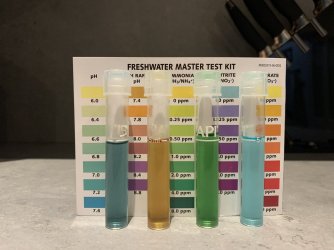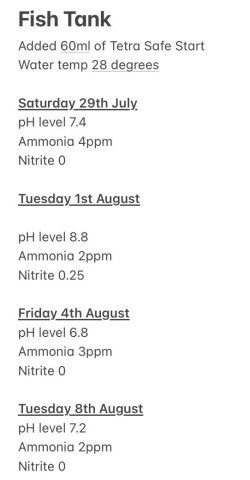The issue of pH and cycling is not as simple as most would like it. However, pH most definitely has an effect on cycling. It is the biology and chemistry involved which explains things.
The ammonia oxidizing bacteria prefer to have ammonia as NH3. This is ammonia gas. However, water does strange things with a lot of chemistry. When ammonia (NH3) gets dissolved in water. most of it becomes ammonium (NH4). It is possible to know how much of the ammonia in water is in each form.
Most of our hobby test kits measure what is known as Total Ammonia (TA). This is sum and any NH3 + NH4 in the water. The higher the pH is and the higher the water temperature is, the more of the TA will be in the form of NH3. However, pH is much more important than temp. in determing this NH3 is what harms our fish etc. NH4 is way less toxic. But, for the bacteria it is "food."
So, when NH3 or NH4 enters the water, it will get re-balanced into whatever proportion the pH and temp. dictates. But, as the pH drops below 7, the amount of NH3 decreases rapidly. By pH 6.0 there is almost 0 in the form of NH3. So how can the bacteria survive? Science knew there was little or no ammonia/ammonium in the water at lower pH levels, but they did not know why this was the case. Reseach figured it out.
The bacteria prefer NH3 and they have lots of "receptors" for it. However, they also have some for NH4, but nowhere near as many. Basically, the bacteria cannot process NH$ as effectively as they can NH3. So, when we are cycling a tank and the pH starts to drop under 7, the bacteria are not working as well. This means ammonia levels are going to start to rise the lower the pH goes.
For us, what appears to happen is that the cycle stalls when the water becomes acid. Ammonia levels do not drop and may even rise. But the bacteria are still and worming, but less efficiently. What has to happen is that they need to reproduce so there are more of them. But they reproduce somewhat slowly. In optimal conditions they can double their numbers in about 8 hours. But now the conditions are nowhere near optimal.
If we do nothing at this time out tank will still get cycled, but it will take a lot longer is all. So, in the interest of having the task iof cycling a new tank happen in a generally predictable manner and within a reasonable amount of time, folks like me who write cycling articles will say not tot let the pH drop much under 7.0. If it does and your cycle slows we advise taking counter measures. These can be as simple as a water change or adding crushed coral in a bag or both. These raise the pH and the cycle gets back on its intended track.
When I finally decided to take my shot at keeping Altum angels all of the above was involved. I was getting imported fish which came out of water with almost no TDS and a pH in the 4.0 range. I had a tank close to those conditions. I knew any ammonia in the water would be NH4. Way less harmfull and more easily managed. And I had a clever plan. Over the next 6 months I waould gradually raise the angel tank pH to 6.0. I set up a second tank as a bio-farm where I was fishless cycling filters for ultimate use.
I started it at 7.0 and when it was fully cycled, I dropped the pH by.02. I then added more ammonia and made sure it was cycled for 6.8. I repeated this process until the filters were working at 6.0 water. Each step took about 2-3 week. I wasn't sure when I started it how long it would take, The goal was when the angel tanks reached 6.0 the bio-farm would be work,ing there as well and I would simple move over the filters.
My mistake was not realizing that I did not need to do the bio-farm. The angel tank would self cycle, which it did. The first seller from whom I bought Altums which I picked up from his home had told me his tanks at about 5.0 pH had self cycled. I argue he had to be wrong. He wasn't, I was wrong.
This hobby has a lot of what I call "urban aquarium myths." Many can lead to unwanted results, However, some like the one about a cycle stopping in acid pH is actually a helpful one for new keepers. most os us want to have fish ASAP when we get our first tank. So it helps to be given instructions on fishless or fish in cycling as it is done.
Finally, while it is true that NH4 is way less harmful than NH3, that does not mean that NH4 is harmless. The level it is at and the amounts of time involved matter. It is poosible to determine the amount of NH3 in any sample with measurable TA as long as you know the pH, temp. and salinity of the water involved.
If you want to have some fun running simulations re the above for fresh, brackish or salt water, here is a link to the ammonia calculator I put in this article on the site here
https://www.fishforums.net/threads/rescuing-a-fish-in-cycle-gone-wild-part-il.433778/
Edited to add the following:
However, the EPA recommends that public water systems maintain pH levels of between 6.5 and 8.5, a good guide for individual well owners. Water with a low pH can be acidic, naturally soft and corrosive. Acidic water can leach metals from pipes and fixtures, such as copper, lead and zinc.
This is why most municipal water systems want water with a pH that is not acidic,
Most of us on this site likely do not have tap water with a pH lower than 6.5 and few have even that low. So, for most the idea that cycling stalls at 6.5 or below is not really relevant. For new fishkeepers wanting to cycle their first tank in short order, holding the pH at 7 or above during the cycle is fine as long as one knows where it will settle out based on t6heir tap water levels.
And the cycling article here does not state that the cycle stops at 6.0, it says it "appears to stop." It also says it slows as the pH drops under 7.0.





